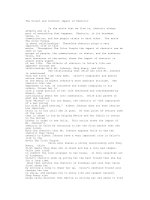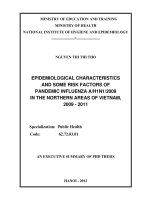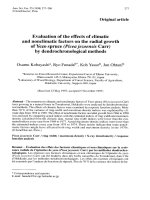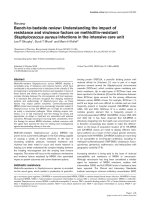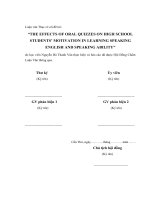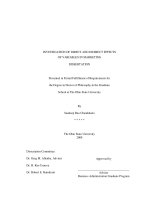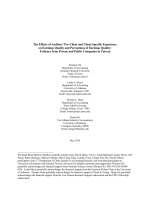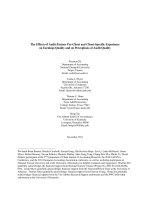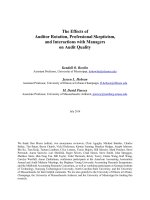The direct and indirect effects of times of visits, length of stay, push and pull factors on tourist loyalty through the mediation of tourist destination satisfaction
Bạn đang xem bản rút gọn của tài liệu. Xem và tải ngay bản đầy đủ của tài liệu tại đây (1.08 MB, 106 trang )
The Direct and Indirect Effects of Times of Visits, Length of Stay, Push and Pull
Factors on Tourist Loyalty through the Mediation of Tourist Destination Satisfaction
A study of international leisure tourists in Ho Chi Minh City
In Partial Fulfillment of the Requirements of the Degree of
MASTER OF BUSINESS ADMINISTRATION
In Finance
By
Mrs. Nguyen Thi Mai Phuong
ID: MBA06024
International University - Vietnam National University HCMC
August 2014
The Direct And Indirect Effects Of Times Of Visits, Length Of Stay, Push And Pull
Factors On Tourist Loyalty Through The Mediation Of Tourist Destination Satisfaction
A study of international leisure tourists in Ho Chi Minh City
In Partial Fulfillment of the Requirements of the Degree of
MASTER OF BUSINESS ADMINISTRATION
In Finance
by
Mrs. Nguyen Thi Mai Phuong
ID: MBA06024
International University - Vietnam National University HCMC
August 2014
Under the guidance and approval of the committee, and approved by all its members, this
thesis has been accepted in partial fulfillment of the requirements for the degree.
Approved:
---------------------------------------------Chairperson
--------------------------------------------Committee member
---------------------------------------------Committee member
--------------------------------------------Committee member
---------------------------------------------Committee member
--------------------------------------------Committee member
Acknowledge
Foremost, I would like to express my very great appreciation to my advisor, PhD. Mai Ngoc
Khuong for his valuable and constructive suggestions during the research process. His
willingness to give his time so generously has been very much appreciated. His patient
guidance, enthusiastic encouragement and useful critiques helped me gain a lot of knowledge
and experiences. In addition, when I had some problems in the research process, Dr. Khuong
always gave me the exemplary advice, constant assistance and valuable support. The help and
guidance given by him time to time shall carry me a long way in the journey of life on which
I am about to embark.
Secondly, I wish to acknowledge the help provided by my lecturers at School of Business
Administration, Graduate programs, International University (Vietnam National University –
Ho Chi Minh City) for their teaching, cordial support, valuable information and guidance. All
knowledge and experiences that I have learned in two years at the university here contributed
very much to the completion of this study.
Furthermore, I also take this opportunity to express my special thanks to all my respondents,
whose valuable information, precious time and support helped me to complete this research.
Last but not least, I am particularly grateful for the assistant given by my friends, Mr. Quach
Binh, Mr. Nguyen Tan Thoi, … and my sister Ms. Nguyen Thi Yen Phuong for helping me in
collecting data. Especially, I am grateful for the willing help of my dear husband and family.
Without all of their precious support, this research would not be possible.
i
Plagiarism Statements
I would like to declare that, apart from the acknowledged references, this thesis either does
not use language, ideas, or other original material from anyone; or has not been previously
submitted to any other educational and research programs or institutions. I fully understand
that any writings in this thesis contradicted to the above statement will automatically lead to
the rejection from the MBA program at the International University – Vietnam National
University Hochiminh City.
ii
Copyright Statement
This copy of the thesis has been supplied on condition that anyone who consults it is
understood to recognize that its copyright rests with its author and that no quotation from the
thesis and no information derived from it may be published without the author‟s prior consent.
© Nguyen Thi Mai Phuong/ MBA06024/ 2014
iii
Table of Contents
ACKNOWLEGDE ............................................................................................................. i
PLAGIARISM STATEMENT ........................................................................................ ii
COPYRIGHT STATEMENT ......................................................................................... iii
LIST OF TABLE ........................................................................................................... viii
LIST OF FIGURE ........................................................................................................... ix
ABSTRACT ........................................................................................................................x
CHAPTER I: INTRODUCTION ....................................................................................1
1. Background of the research ...................................................................................1
2. Problem Statement ..................................................................................................3
3. Research Question ...................................................................................................3
4. Research Objectives ................................................................................................4
4.1 General Objective ............................................................................................4
4.2 Specific Objectives ...........................................................................................4
5. Significances and Implications ...............................................................................4
6. Scope and Limitation ..............................................................................................5
CHAPTER II: LITERATURE REVIEW ......................................................................7
1. Push and Pull Travel Motivations .........................................................................7
1.1 Definition and Concept ...................................................................................7
1.2 Travel Motivations Determinants .................................................................8
1.2.1 Push Determinant ..................................................................................9
iv
1.2.2 Pull Determinant ..................................................................................10
2. Tourist Destination Satisfaction ...........................................................................11
2.1 Definition and Concept ..................................................................................11
2.2 Determinants of Tourist Destination satisfaction .......................................13
3. Tourist Loyalty .......................................................................................................14
4. Number of Visits ....................................................................................................16
5. Length of Stay ........................................................................................................19
6. Travel Motivations, Number of Visits, Length of Stay,
Destination Satisfaction and Tourists Loyalty .......................................................20
7. Conceptual Framework ........................................................................................25
8. Hypotheses ..............................................................................................................26
CHAPTER III: METHODOLOGY .............................................................................. 27
1. Research Process ...................................................................................................27
2. Research Design ................................................................................................... 28
3. Target Sample .......................................................................................................28
4. Sample Size ........................................................................................................... 29
5. Data Collecting ..................................................................................................... 29
5.1 Primary Data ................................................................................................ 29
5.2 Secondary Data ............................................................................................ 30
6. Questionnaire Design .............................................................................................30
7. Data Analysis .........................................................................................................34
8. Reliability Test .......................................................................................................36
9. Exploratory Factor Analysis (EFA) .....................................................................38
9.1 EFA for Independent Variables ...................................................................39
9.2 EFA for Mediate and Dependent Variables ................................................41
v
CHAPTER IV: DATA ANALYSIS AND FINDINGS .................................................43
1. Sample Demographic .............................................................................................43
1.1 Gender .............................................................................................................44
1.2 Age Group.......................................................................................................45
1.3 Country ...........................................................................................................45
1.4 Relationship Status ........................................................................................46
1.5 Number of Visits to Vietnam ........................................................................48
1.6 Party Composition .........................................................................................49
1.7 Travel Mode to Vietnam ...............................................................................49
1.8 Length of Stay in Vietnam ............................................................................50
2. Descriptive Statistics ..............................................................................................51
2.1 Push Determinant ..........................................................................................51
2.2 Pull Determinant ............................................................................................53
2.3 Destination Satisfaction .................................................................................54
2.4 Tourists Loyalty .............................................................................................56
3. Multiple Regression ...............................................................................................58
3.1 Factors affect Destination Satisfaction.........................................................58
3.2 Factors affect Tourists Loyalty directly .......................................................60
3.3 Factors affect Tourists Loyalty indirectly through the mediation Destination
Satisfaction............................................................................................................62
3.4 Relationship between Destination Satisfaction and Tourists Loyalty .......64
4. Path Analysis ..........................................................................................................65
4.1 Direct Effect on Tourists Loyalty .................................................................66
4.2 Indirect Effect on Tourists Loyalty ..............................................................66
4.3 Path diagram of Tourists Loyalty ................................................................66
vi
CHAPTER V- DISCUSSTION AND RECCOMENDATION ....................................69
1. Discussion of Findings ...........................................................................................69
1.1 The Influence of Push, Pull Factors, Number of Visits,
Length of Stay on Destination Satisfaction ........................................................69
1.2 The Influence of Push, Pull Factors, Number of Visits,
Length of Stay, Destination Satisfaction on Tourists Loyalty .........................70
1.3 Summary of Research Findings....................................................................72
2. Recommendations for Ho Chi Minh and Vietnam Tourism .............................74
3. Conclusion ..............................................................................................................76
LIST OF REFERENCES ................................................................................................77
APPENDIX .......................................................................................................................91
vii
List of Tables
Table 1: Items of Measurement Scale ................................................................................................ 31
Table 2: Cronbach's Alpha of Variables ............................................................................................ 37
Table 3: KMO and Bartlett's Test of 9 Travel Motivation attributes ................................................. 39
Table 4: Factor Loadings and Reliability of Independent Variables ................................................. 40
Table 5: KMO and Bartlett's Test of Mediate and Dependent Variables .......................................... 41
Table 6: Factor Loadings and Reliability of Mediate and Dependent Variables ............................... 42
Table 7: Demographics of the Sample (Personal Information) ......................................................... 43
Table 8: Demographics of the Sample (Travel Information) ............................................................. 47
Table 9: Demographics of the sample (Length of stay in Vietnam) .................................................. 50
Table 10: Descriptive Statistics of Push Factor ................................................................................. 52
Table 11: Descriptive Statistics of Pull Factor................................................................................... 53
Table 12: Descriptive Statistics of Destination Satisfaction .............................................................. 55
Table 13: Descriptive Statistics of Destination Loyalty .................................................................... 56
Table 14: Pearson‟ Correlations between PUSFAC, PULFAC, Number of Visits, Length of stay
and TODESA ................................................................................................................... 58
Table 15: Coefficients between PUSFAC, PULFAC and TODESA ................................................. 59
Table 16: Pearson‟ Correlations between PUSFAC, PULFAC, Number of visits, Length of stay
and TOULOY .................................................................................................................. 60
Table 17: Coefficients between PUSFAC, PULFAC, Number of visits and TOULOY ................... 61
Table 18: Pearson‟ Correlations between PUSFAC, PULFAC, Number of visits, Length of stay,
TODESA and TOULOY.................................................................................................. 63
Table 19: Coefficients between PUSFAC, PULFAC, Number of visits, TODESA and TOULOY.. 64
Table 20: Pearson‟ Correlations between TODESA and TOULOY ................................................. 64
Table 21: Coefficients between TODESA and TOULOY ................................................................. 65
Table 22: Direct, Indirect and Total Causal Effects ........................................................................... 66
Table 23: Results of the Research‟s Hypotheses ............................................................................... 73
viii
List of Figures
Figure 1: The relationship between customer satisfaction & customer loyalty
(Heskett et al., 2008) ..................................................................................................15
Figure 2: Results of the hypothesized model (Chi and Qu, 2008) .........................................21
Figure 3: Results of the hypothesized model (Chi, 2012) .....................................................23
Figure 4: Research Conceptual Framework ...........................................................................25
Figure 5: The Research Process .............................................................................................27
Figure 6: Percentage of Gender .............................................................................................45
Figure 7: Percentage of Age group ........................................................................................45
Figure 8: Percentage of Country ............................................................................................46
Figure 9: Percentage of Relationship Status ..........................................................................46
Figure 10: Percentage of Number of visits to Vietnam .........................................................48
Figure 11: Percentage of Party Composition .........................................................................49
Figure 12: Percentage of Travel mode to Vietnam ................................................................49
Figure 13: Percentage of Length of stay in Vietnam .............................................................51
Figure 14.1: Path Coefficients of the Structural Equation for H1 Testing .............................67
Figure 14.2: Path Coefficients of the Structural Equation for H2 Testing .............................67
Figure 14.3: Path Coefficients of the Structural Equation for H3 Testing .............................67
Figure 14.4: Path Coefficients of the Structural Equation for H4 Testing .............................68
ix
Abstract
The purpose of this research is to examine empirically the causal relationships among travel
motivations, number of visits, length of stay, destination satisfaction and tourist loyalty of
international leisure tourists in Ho Chi Minh City. The research conceptual framework and
hypotheses were constructed, based on previous theoretical and empirical studies. A survey
was conducted with 313 respondents to collect the primary data. Multiple regression and Path
analyses were used to test the research hypotheses. As a result, push, pull factors and number
of visits have significant and positive influence on tourist‟s destination satisfaction and tourist
loyalty to Vietnam. However, length of stay does not affect those directly and indirectly.
Consequently, business organizations working in the tourism sector should take into account
the essential roles of push and pull factors, increasing the number of visits, in order to attract
more potential visitors, enhance their destination satisfaction and encourage them to re-visit
to Vietnam in the near future.
Keywords: Push and pull factors, Number of visits, Length of stay, Destination
satisfaction, Tourists loyalty.
x
xi
Relationship Between Number Of Visits, Length Of Stay, Travel Motivations,
Destination Satisfaction and Tourists Loyalty
CHAPTER ONE
INTRODUCTION
1. Background of the Research
Tourism is one of the most essential multinational business activities in the world
(Friedman, 1995), brings appreciate 30% of the world‟s exports of services and has
become the major income of many countries. In Vietnam, tourism is an important
industry of the Vietnamese economy, and contributes 5.3% to Gross Domestic Product
(GDP) and expected to 7.5% by 2030, according to the General Plan to develop
Vietnam‟s tourism until 2020 with a vision to 2030, which has recently been
approved by the Government. Vietnam is one of the most attractive tourist destinations
in Asia and the Pacific area and is predicted in the top group of emerging destinations for
international visitors in 2014, holds the second place after Myanmar (United States Tour
Operators Association - USTOA).
The total international arrivals coming to Vietnam reached 7,572,352 in 2013, increasing
10.6% over the previous year, with 4,640,882 leisure tourists and accounted for more
than 60% (Vietnam General Statistics Office). In addition, according to the Ministry of
Culture, Sport & Tourism - Vietnam National Administration of Tourism, the total
revenue of Vietnamese tourism industry in 2013 was more than VND 200,000 billion,
increasing 25% compared to 2012. Regarding to Ho Chi Minh City, the number of
international visitors to the city was estimated at 4,109,000 in 2013, increasing 8.1%
compared to 2012, reaching 100.2% of the plan and accounting for 55% of international
visitors to Vietnam. The revenue was approximately VND 83,191 billion, increasing 17%
1
Relationship Between Number Of Visits, Length Of Stay, Travel Motivations,
Destination Satisfaction and Tourists Loyalty
compared to 2011, reaching 100% of the plan, accounting for 44% of Vietnam's tourism
revenue, and contributing to more than 11% of the city's GDP (Ho Chi Minh City
Department of Culture, Sports and Tourism).
International tourists to Vietnam come from a variety of countries and regions, with
diverse cultural backgrounds. The top ten proportions consist of China, Korea, Japan,
United States, Taiwan, Cambodia, Malaysia, Australia, Thailand, and France (Ministry
of Culture, Sport & Tourism - Vietnam National Administration of Tourism, 2013).
However, there is a sad truth that the percentage of returning tourists to Vietnam is still
not high. It is not over 20% (Ministry of Culture, Sport & Tourism - Vietnam National
Administration of Tourism, 2012) comparing with high rate of Thailand, Singapore, and
Malaysia…In order to increase the returning rate, Vietnam tourism need to increase
international tourists‟ satisfaction and make Vietnam become a loyal destination of those.
There are many researchers studying travel satisfaction and destination loyalty, finding out
important factors affect tourists‟ destination satisfaction, their loyalty and willingness to
recommend as well. For example, a variety of conceptual and empirical studies have shown
that causal relationship among tourists‟ satisfaction, loyalty and their travel motivation
(Yoon & Uysal, 2005; Tkaczynski, Hastings, & Beaumont, 2006; Qiao et al., 2008; Kim,
2008; Lee, Jeon, & Kim, 2011; Tang, 2013; Pratminingsih, Rudatin, & Rimenta, 2014),
number of visits (Kozak, 2001; Mazursky, 1989; Chi, 2012; Lau & McKercher,
2004),destination image (Chen & Tsai, 2007; Chi & Qu, 2008; Ozturk & Qu, 2008;
Mechinda et al., 2010; Sadeh et al., 2012; Jamaludin et al., 2012), etc.
Especially, travel motivations, length of stay and number of visits have the clear impact on
tourists‟ destination satisfaction and their loyalty. According to Kozak (2001); Mazursky
(1989); Chi (2012); Lau & McKercher (2004), they confirm the effect among those and
2
Relationship Between Number Of Visits, Length Of Stay, Travel Motivations,
Destination Satisfaction and Tourists Loyalty
show that understanding that relationship is vital to increase the returning and loyal rate
of tourists.
2. Problem Statement
Tourists‟ travel motivation has an important role in explaining their travel decision as
well as their behavior. It includes internal or psychological forces (push factors) and
external forces of the destination attributes (pull factors). In addition, number of visits
and length of stay are also very important elements that many countries use them as tools
to measure how satisfied the tourists are. Therefore, understanding the motivations
differences among foreign visitors and the relationships between travel motivation, times
of visits, length of stay, destination satisfaction and tourist loyalty are the serious
challenges of Vietnamese tourism destination management, in order to adapt and/or
adjust tourist products and services to improve destination image and attract more
potential customers on around the world to Vietnam, as well as maximize recent tourists‟
satisfaction and increasing revisit rate in the near future.
This thesis research studied on tourist destination satisfaction and tourist loyalty to
Vietnam based on their travel motivation, by analyzing the effect of push and pull factors
and identifying the number of visits and length of stay. The study focused on
international leisure tourists in Ho Chi Minh City during the period surveyed.
3. Research Question
From the problem statement, the study raised the following research question: “To what
extent do factors of times of visit, length of stay, push and pull factors directly and
indirectly affect tourist loyalty toward Ho Chi Minh City Destination?”
3
Relationship Between Number Of Visits, Length Of Stay, Travel Motivations,
Destination Satisfaction and Tourists Loyalty
4. Research Objectives
4.1 General Objective
This research is aimed at exploring and understanding travel motivation of foreign
leisure tourists in Ho Chi Minh City; thereby, evaluating the causal relationship between
their travel motivations, number of visits, length of stay, destination satisfaction and their
loyalty.
4.2 Specific Objectives
The specific objectives of this research include:
-
To identify push and pull travel motivations, number of visits, length of stay,
destination satisfaction and tourists loyalty of international leisure tourists in Ho
Chi Minh City.
-
To identify the direct effect of tourists‟ travel motivations, number of visits and
length of stay on their destination satisfaction.
-
To identify the direct effect of tourists‟ destination satisfaction toward their
loyalty to Vietnam.
-
To evaluate the direct and indirect influence of tourists‟ travel motivations,
number of visits and length of stay on their loyalty to Vietnam through their
destination satisfaction.
5. Significances and Implications
Basing on the empirical research findings, this study provides practical evidences about
the relationship between push and pull travel motivations, number of visits, length of
4
Relationship Between Number Of Visits, Length Of Stay, Travel Motivations,
Destination Satisfaction and Tourists Loyalty
stay, destination satisfaction and tourist loyalty to Vietnam of international visitors; in
order to increase the awareness of Vietnamese tourism organizations about the role of
travel motivations, number of visits, and their influence on tourist satisfaction and
loyalty
to
Vietnam
destination.
Lastly,
this
study
proposes
constructive
recommendations to Vietnamese destination marketers developing tourism strategies and
plans, to make Vietnam become more attractive and therefore, increase tourists‟
satisfaction and their loyalty.
6. Scope and Limitation
Because of the lacking of time and resources in the research process, this research cannot
avoid some issues associated with this study‟s limitations which are identified and
discussed in depth below. The constructive recommendations to further researches are
also proposed; thus, similar studies in the future could control and restrict these
limitations in order to enhance the accuracy of research results.
First of all, this research only focuses on international leisure tourists who came to Ho
Chi Minh City during the research period of time with the sample size of 313. Because
of the limitation in size and research scope, it may not totally represent for the whole
foreign tourists in Ho Chi Minh City and in Vietnam.
In addition, this research only conducts quantitative data collection method, so that the
findings from each respondent are not really explained and analyzed in depth.
Qualitative data collection methods such as interview and focus group should be
considered to conduct with quantitative data collection method. In addition,
questionnaire is used to collect the empirical data for this research. It was designed in
English only. Because of the limitation and barrier in language, the misunderstanding of
tourists in the questionnaire‟s questions may decrease the accuracy of research results.
5
Relationship Between Number Of Visits, Length Of Stay, Travel Motivations,
Destination Satisfaction and Tourists Loyalty
As regards research field, this research just studies on travel motivation, number of visits,
destination satisfaction and tourist loyalty to Vietnam destination, does not mention
other aspects of tourist behavior such as trip planning, motivation, travel decision, etc.
Thus, it cannot express tourist behavior completely. In addition, travel motivation and
number of visits are only two of many factors influencing the customer behavior;
therefore, it may not totally influence on the destination satisfaction as well as tourist
loyalty of foreign leisure tourists.
Finally, the conceptual framework of this research was based on some previous studies
and tested in a specific destination only – Ho Chi Minh City, Vietnam. Other
destinations with their own attributes could change tourists‟ travel motivation as well as
their satisfaction and loyalty; hence, the results of the proposed model were also
different from this study and others. Future researchers should conduct and test the
research model in some different destinations, in order to have a completely picture
about this causal relationship as well as explore finding differences among these
destinations.
6
Relationship Between Number Of Visits, Length Of Stay, Travel Motivations,
Destination Satisfaction and Tourists Loyalty
CHAPTER TWO
LITERATURE REVIEW
1. Push and Pull Travel Motivations
1.1 Definition and Concept
Motivation is one of the main driving forces used to interpret the behavior of an
individual. It is a process of “internal psychological factors” such as needs, desires and
goals, which make a person to act or behave in a certain way, in order to achieve his or
her goals and expecting satisfaction (Fodness, 1994; Backman et al., 1995; Beerli &
Martı´n, 2004).
In addition, travel motivation is defined as “a set of attributes that cause a person to
participate in a tourist activity” (Pizam, Neumann, & Reichel, 1979). In particular, travel
motivation relates to the reason of travelers‟ decision making in travelling and choosing
to visit a particular attraction or destination instead of others (Cropmton, 1979). Lubbe
(1998) stated that travel motivation to a certain destination is begun by certain needs of
individuals, who perceive that destinations would serve and satisfy their needs.
Therefore, travel motivation is a significantly important aspect which should be
recognized, to expand and develop destination marketing in order to be competitive in
the market.
In many tourism studies, travel motivation is considered as the starting point and one of
the most important psychological influences to understand tourist behavior (Crompton,
1979; Kim, Lee & Klenosky, 2003; George, 2004; March & Woodside, 2005). It plays a
7
Relationship Between Number Of Visits, Length Of Stay, Travel Motivations,
Destination Satisfaction and Tourists Loyalty
useful foundation in attempting to explain the ways tourists behave, the destination they
travel, and the activities they participate in this destination. Because travel motivations
have a direct impact on tourist decisions, understanding and having the adequate
knowledge about them are essential and necessary, in order to predict and control travel
patterns in the future (Uysal & Hagan, 1993) and further enhancing travel satisfaction
and destination loyalty (Yoon & Uysal, 2005; Tkaczynski, Hastings, & Beaumont, 2006;
Qiao et al., 2008; Kim, 2008; Lee, Jeon, & Kim, 2011; Tang, 2013; Pratminingsih,
Rudatin, & Rimenta, 2014) for a successful and lasting business.
1.2 Travel Motivation Determinants
Generally accepted approaches in examining the tourist motivation are the concept of
push and pull factors (Crompton, 1979; Dann, 1977, 1981; Pearce & Caltabiano, 1983;
Pyo, Mihalik & Uysal, 1989; Yuan & McDonald, 1990; Uysal & Hagan, 1993; Uysal &
Jurowski, 1993; Klenosky, 2002; Lam & Hsu, 2006; Aswin, 2008, Qiao et al., 2008).
This model involves the theory that people travel because they are pushed and pulled to
do so (Baloglu and Uysal, 1996). The concept of push and pull travel motivation has
become one of the most popular and useful frameworks to study and analyze tourist
behavior. Those two factors explain people travel because they are pushed by their own
internal forces and pulled by the external forces of destination attributes. Push
motivations correspond to a tourist‟s desire and emotional frame of mind while pull
motivations represent the attributes of the destination to be visited (Crompton, 1979).
The characteristics of each motivation determinant are discussed below:
8
Relationship Between Number Of Visits, Length Of Stay, Travel Motivations,
Destination Satisfaction and Tourists Loyalty
1.2.1 Push Determinant
Push motivations are the determinants that motivate or create the intangible or intrinsic
desires of the individual travelers to go on a vacation (Crompton, 1979; Uysal & Hagan,
1993; Uysal & Jurowski, 1993). Push factors, on the other hand, refer to the tourist as a
subject and deal with those factors driving him to travel (e.g. escape, nostalgia, etc.)
(Dann, 1977). He further explained that push factors deal with tourist motivation itself.
According to Crompton (1979), the push factor consists of seven socio-psychological
motives and two cultural motives. The seven socio-psychological motives are escape,
self-exploratory, relaxation, prestige, regression, kinship enhancement, and social
interaction; while novelty and education are two cultural motives. These push factors are
recognized as the first step and useful tool in explaining the desire for travel and
understanding tourists‟ behavior (Crompton, 1979).
In addition, Uysal & Hagan (1993), Kim, Lee & Klenosky (2003), Yoon & Uysal (2005),
Lam & Hsu (2006), in their studies, identified escape, novelty seeking, adventure
seeking, dream fulfillment, rest and relaxation, health and fitness, prestige, and
socialization as dimensions of push motivation. In more recent studies, push factor was
measured similarly: getting away, adventure and excitement, discovery and learning,
connecting with family and friends, engaging nature, rejuvenation, and spending time
with special persons (Kim, 2008); novelty, relaxation, psychological satisfaction,
prestige, and human relationship (Qiao et al., 2008).
For the purpose of this study, push motivations include escape, novelty, discovery and
learning, rest and relaxation, prestige, family and friends togetherness, social interaction,
and dream fulfillment which are based on previous studies.
9
Relationship Between Number Of Visits, Length Of Stay, Travel Motivations,
Destination Satisfaction and Tourists Loyalty
1.2.2 Pull Determinant
Pull determinant, on the contrary, are tangible resources and traveler‟s perception and
expectation towards the features, attractions, or attributes of a specific destination;
therefore, those motivations play an important role in destination choice of tourists once
the decision to travel has been made (Crompton, 1979; Uysal & Hagan, 1993; Kim, Lee
& Klenosky, 2003). Pull factors are those which attract the tourist to a given resort (e.g.
sunshine, sea, etc.) and whose value is seen to reside in the object of travel (Baloglu and
Uysal, 1996). They have always been conceptualized as relating to the features,
attractions, or attributes of the destination itself (Kim, Lee & Klenosky, 2003). They
represent the specific attractions of the destination which induces the traveler to go there
once the prior decision to travel has been made (Dann, 1981).
Pull motivations are the external forces related to natural and historic attractions, food,
people, recreation facilities, and marketed image of the destination (Uysal & Hagan,
1993). Similarly, Turnbull & Uysal (1995) found six pull factors, including
heritage/culture, city enclave, comfort-relaxation, beach resort, outdoor resources and
rural & inexpensive. Based on previous scholar‟ work, sightseeing attractions, recreation
events and activities, physical amenities, tourist services, food, weather, safety,
accessibility, and affordability of destination are set as pull motivations. Those
characteristics or attributes of a destination can make the tourists satisfy their needs and
expectations on a vacation.
Dann (1981), Klenosky (2002), and Kim (2008) agreed that push and pull motivations
are not independent, but related to each other. While push factors push people to travel,
pull factors simultaneously pull them to choose a particular destination. In addition, the
concepts of push and pull factors are accepted as the primary motivations in many
10
Relationship Between Number Of Visits, Length Of Stay, Travel Motivations,
Destination Satisfaction and Tourists Loyalty
studies of tourist behaviors. Based on the push and pull motivations, as discussed above,
the individual tourists make their decisions about travelling, especially the travel
destination. It means that certain reasons for travel may be predicted, thus, destination
marketers and promoters in the tourism industry should keep in mind about the
importance of travel motivations, and give more marketing efforts to matching the main
attributes of a destination with the needs and expectations of potential tourist customers
(Gnoth, 1997; You et al., 2000).
2. Tourist Destination Satisfaction
2.1 Definition and Concept:
Bolton & Drew (1991, p.2) state: “A customer‟ satisfaction/ dissatisfaction with a
service […] depends on his or her current perception of performance, prior expectations
about performance and perceptions of the discrepancy between these two constructs.”
Several studies have proven that customer satisfaction together with quality is one of the
key drivers of service performance for a company (Anderson et al. 1994; Fornell 1992).
Hence, companies should offer services that are able to satisfy not only the consumers‟
expectations but also their perceptions of service quality. As they may however differ
from customer to customer, companies should evaluate the perceptions and expectations
of customers on a regular basis. On this ground, it is eminent to constantly assure service
performance in order to increase or at least preserve customer satisfaction. The degree of
satisfaction is furthermore believed to increase the probability of repurchase through a
customer, hence eminent for a successful company.
O‟Neil (in Kandampully et al. 2001) conclusively states that if the customer experiences
better service than expected a high level or positive disconfirmation and therefore
satisfaction will result (also discussed in Rust & Oliver 1994).
11
Relationship Between Number Of Visits, Length Of Stay, Travel Motivations,
Destination Satisfaction and Tourists Loyalty
It was Heskett et al. (1994) who, with their implementation of the service profit chain
model, defined customer satisfaction as a prerequisite to customer loyalty. This customer
loyalty then again would result in profitability.
On the other hand, a tourist destination is an amalgam of tourist products, services and
public goods consumed under the same brand name, thus offering the consumer an
integrated experience (Buhalis, 2000; Leiper, 1995). Rather than describing it in terms of
a well-defined geographical area such as a country, island or town (Davison and
Maitland, 1997; Hall, 2000), contemporary definitions view a destination as a blend of
consumers‟ space and tourism products providing a holistic experience which is
subjectively interpreted according to the consumer‟s travel itinerary, cultural background,
purpose of visit, past experience, etc. (Fuchs and Weiermair, 2003).
Moreover, tourism destinations can be defined as temporary locations for gaining a
travel experience, and which is related to the destination‟s attractiveness (Leiper, 1979).
According to another perspective and related to an individual‟s travel requirements,
tourism destinations can be evaluated as reflections of emotions, beliefs and thoughts in
enabling perceived satisfaction (Hu, Ritchie, 1993). Uysal (1998) evaluates destination
attractiveness and sources, as supply factors representing pushing forces, which
constitute tourist demand. Naturally, tourists will have expectations from tourism
destinations, in terms of attractiveness and sources. These expectations can be increased
or decreased, resulting from publicity and marketing efforts of the tourism destination.
The net result of such efforts will be a specific holiday destination. Receiving new and
relevant information focused on the holiday destination, will help tourists in selecting
their destination - after due consideration is made of their expectations. Normally,
expectations of a destination will affect satisfaction levels.
12

